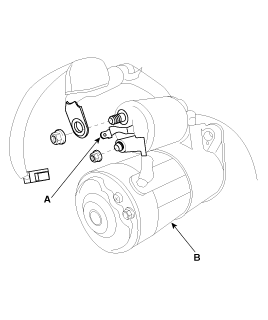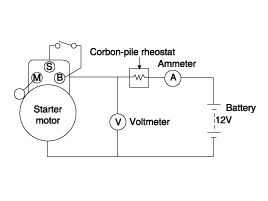 Hyundai Elantra HD: Repair procedures
Hyundai Elantra HD: Repair procedures
Inspection
Start Test
The air temperature must be between 59 and 100°F (15 and 38°C)
before testing.
|
Recommended procedure :
| • |
Use a starter system tester.
|
| • |
Connect and operate the equipment in accordance with the manufacturer's
instructions.
|
| • |
Test and troubleshoot as described.
|
Alternate Procedure :
| • |
Use the following equipment :
- Ammeter, 0~400A
- Voltmeter, 0~20V (accurate within 0.1 volt)
- Tachometer, 0~1,200 rpm
|
| • |
Hook up a voltmeter and ammeter as shown.
|
After this test, or any subsequent repair, reset the ECM/PCM to
clear any codes.
|
Check the Starter Engagement :
| 1. |
Remove the No.8(10A) fuse from the fuse/relay box.
|
| 2. |
Turn the ignition switch to START (III) with the shift lever in
or position (A/T) or with the clutch pedal depressed (M/T). The starter
should crank the engine.
|
| 3. |
Check the battery, battery positive cable, ground, starter cut
relay, and the wire connections for looseness and corrosion. Test again.
If the starter still does not crank the engine, go to step 4.
|
| 4. |
Unplug the connector from the starter.
|
| 5. |
Connect a jumper wire from the battery positive (+) terminal to
the solenoid terminal.
The starter should crank the engine.
|
| 6. |
Check the ignition switch.
|
| 7. |
Check the starter relay.
|
| 8. |
Check the A/T gear position switch (A/T) or the clutch interlock
switch (M/T).
|
| 9. |
Check for an open in the wire between the ignition switch and
starter.
|
If cranking voltage is too low, or current draw
too high, check for :
| • |
dead or low battery.
|
| • |
open circuit in starter armature commutator segments.
|
| • |
starter armature dragging.
|
| • |
shorted armature winding.
|
| • |
excessive drag in engine.
|
Check Cranking rpm
Engine speed during cranking should be above 100 rpm.
If speed is too low, check for :
| • |
loose battery or starter terminals.
|
| • |
excessively worn starter brushes.
|
| • |
open circuit in commutator segments.
|
| • |
dirty or damaged helical splines or drive gear.
|
| • |
defective drive gear overrunning clutch.
|
Check starter disengagement
With the shift lever in N or P position (A/T) or with the clutch pedal
depressed (M/T), turn the ignition switch to START(III), and release to ON(II).
The starter drive gear should disengage from the torque converter ring
gear or flywheel ring gear when you release the key.
If the drive gear hangs up on the torque converter ring gear or flywheel
ring gear, check for :
| • |
solenoid plunger and switch malfunction.
|
| • |
dirty drive gear assembly or damaged overrunning clutch.
|
Starter Solenoid Test
| 1. |
Check the hold-in coil for continuity between the S terminal(A)
and the armature housing(B) (ground). The coil is OK if there is continuity.
|
| 2. |
Check the pull-in coil for continuity between the S and M terminals.
The coil is OK if there is continuity.
|
Free Running Test
| 1. |
Place the starter motor in a vise equipped with soft jaws and
connecta fully-charged 12-volt battery to starter motor as follows :
|
| 2. |
Connect a test ammeter (100-ampere scale) and carbon pile rheostatas
shown is the illustration.
|
| 3. |
Connect a voltmeter (15-volt scale) across starter motor.
|
| 4. |
Rotate carbon pile to the off position.
|
| 5. |
Connect the battery cable from battery's negative post to the
startermotor body.
|
| 6. |
Adjust until battery voltage shown on the voltmeter reads 11 volts.
|
| 7. |
Confirm that the maximum amperage is within the specifications
andthat the starter motor turns smoothly and freely :
|




